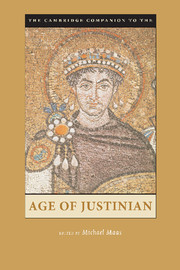Book contents
- Frontmatter
- Part 1 Structures and Ideologies of Empire
- Part 2 Religion and Philosophy
- 9 The Legacy of Chalcedon
- 10 Society and Community in the Christian East
- 11 Emperors and Popes in the Sixth Century
- 12 Christian Piety and Practice in the Sixth Century
- 13 Philosophy in the Age of Justinian
- Part 3 Literature and the Arts
- Part 4 Peoples and Communities
- Bibliography
- Index
- Plate Section 1
- Plate Section 2
9 - The Legacy of Chalcedon
Christological Problems and Their Significance
from Part 2 - Religion and Philosophy
Published online by Cambridge University Press: 28 May 2006
- Frontmatter
- Part 1 Structures and Ideologies of Empire
- Part 2 Religion and Philosophy
- 9 The Legacy of Chalcedon
- 10 Society and Community in the Christian East
- 11 Emperors and Popes in the Sixth Century
- 12 Christian Piety and Practice in the Sixth Century
- 13 Philosophy in the Age of Justinian
- Part 3 Literature and the Arts
- Part 4 Peoples and Communities
- Bibliography
- Index
- Plate Section 1
- Plate Section 2
Summary
Perhaps the most astonishing failure of the Age of Justinian was the disintegration of the one Christian Church of the one Christian Empire into two distinct churches - what we now call Eastern Orthodoxy, on one hand, and the Oriental Orthodox (notably the Jacobite and the Coptic churches) on the other, a division only beginning to be healed in our own time. Remarkably, it seems that this division happened not, as a modern might think, because of nationalistic struggles against the empire, or any desire for autonomy by regional churches, but simply because church leaders, emperors, theologians, and monks, most of them devoted to the ideal of one church and one empire, were unable to resolve a longstanding theological dispute over how one was to understand and talk about Christ’s divine-human reality, the debate over Christology. In the end, the dispute left behind it not only divided churches, a weakened empire, and a redefined role for the emperor, but also new ways of thinking and believing that mark the beginning of Byzantium proper and the end of late antiquity.
The Background
Doctrinal Foundations and Founding Legends (100–400)
The kind of Christianity that won the right to call itself the apostolic faith in the first two centuries CE established as authoritative the first three gospels and the teachings of Paul, all of which assumed the genuine humanity of Jesus. That was to be a foundation of mainline Christology. It is significant, however, that heirs of the original Jewish Christians, who seem to have said that Jesus was only a human being, were by 180 being dismissed as heretics, and that in 268 Paul of Samosata was condemned as a heretic for, among other things, saying that Jesus was a man inspired in essentially the same way as a prophet was inspired.
- Type
- Chapter
- Information
- The Cambridge Companion to the Age of Justinian , pp. 215 - 238Publisher: Cambridge University PressPrint publication year: 2005
- 47
- Cited by

